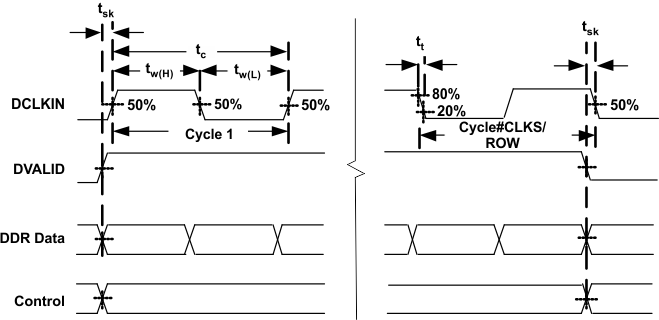ZHCSA85F August 2012 – February 2019 DLPC410
PRODUCTION DATA.
- 1 特性
- 2 应用
- 3 说明
- 4 修订历史记录
- 5 说明 (续)
- 6 Pin Configuration and Functions
- 7 Specifications
-
8 Detailed Description
- 8.1 Overview
- 8.2 Functional Block Diagrams
- 8.3
Feature Description
- 8.3.1
DLPC410 Binary Pattern Data Path
- 8.3.1.1 DIN_A, DIN_B, DIN_C, DIN_D Input Data Buses
- 8.3.1.2 DCLKIN Input Clocks
- 8.3.1.3 DVALID Input Signals
- 8.3.1.4 DOUT_A, DOUT_B, DOUT_C, DOUT_D Output Data Buses
- 8.3.1.5 DCLKOUT Output Clocks
- 8.3.1.6 SCTRL Output Signals
- 8.3.1.7 Supported DMD Bus Sizes
- 8.3.1.8 Row Cycle definition
- 8.3.1.9 DLP9500 and DLP9500UV Input Data Formatting
- 8.3.1.10 DLP7000 and DLP7000UV Input Data Bus
- 8.3.1.11 DLP650LNIR Input Data Bus
- 8.3.2 Data Bus Operations
- 8.3.3 DMD Block Operations
- 8.3.4 Other Data Control Inputs
- 8.3.5 Miscellaneous Control Inputs
- 8.3.6 Miscellaneous Status Outputs
- 8.3.1
DLPC410 Binary Pattern Data Path
- 8.4 Device Functional Modes
- 8.5 Programming
- 9 Application and Implementation
- 10Power Supply Recommendations
- 11Layout
- 12器件和文档支持
- 13机械、封装和可订购信息
7.5 Timing Requirements
(see (4))| MIN | NOM | MAX | UNIT | |||
|---|---|---|---|---|---|---|
| fcd | Clock frequency, DCLKIN_n(1) | 395 | 400 | 400 | MHz | |
| fcr | Clock frequency, CLK_R | 50 | MHz | |||
| tc | Cycle time, DCLKIN_n | 2.5 | 2.5 | 2.53 | ns | |
| tw(H) | Pulse duration, high | 50% to 50% reference points (signal) | 1.25 | 1.25 | 1.27 | ns |
| tw(L) | Pulse duration, low | 50% to 50% reference points (signal) | 1.25 | 1.25 | 1.27 | ns |
| tt | Transition time, tt = tf /tr | 20% to 80% reference points (signal) | .6 | ns | ||
| tjp | Period Jitter DCLKIN_n(2) | 150 | ps | |||
| tSK | Skew, DIN_A(15-0) to DCLKIN_A | –150 | 150 | ps | ||
| Skew, DIN_B(15-0) to DCLKIN_B | –150 | 150 | ||||
| Skew, DIN_C(15-0) to DCLKIN_C | –150 | 150 | ||||
| Skew, DIN_D(15-0) to DCLKIN_D | –150 | 150 | ||||
| Skew, DVALID_n to DCLKIN_n↑ | –150 | 150 | ||||
| Skew, BLK_MD BLK_AD to DCLKIN_n↑(3) | –150 | 150 | ||||
| Skew, ROWMD or ROWAD to DCLKIN_n↑(3) | –150 | 150 | ||||
| Skew, STEPVCC to DCLKIN↑(3) | –150 | 150 | ||||
(1) Preferred DCLKIN_n duty cycle = 50%
(2) This is the deviation in period from ideal period due solely to high frequency jitter.
(3) First edge of DIN*, ROW*, BLK* and STEPVCC should be synchronous to DVALID rising edge
(4) It is recommended that the COMP_DATA, NS_FLIP and RST2BLK flags be set to one value and not adjusted during normal system operation.
 Figure 2. Input Interface Timing
Figure 2. Input Interface Timing  Figure 3. Control Timing
Figure 3. Control Timing NOTE
Dynamic changes to NS_FLIP and COMP_DATA during normal operation is not recommended.